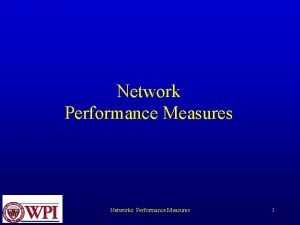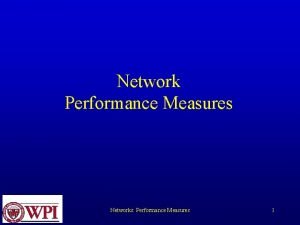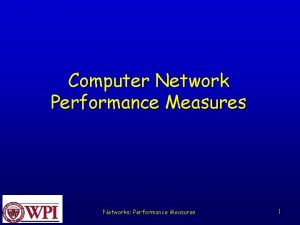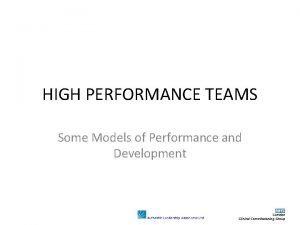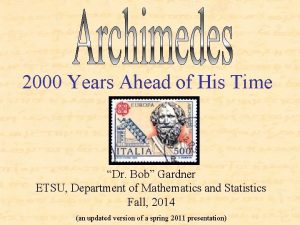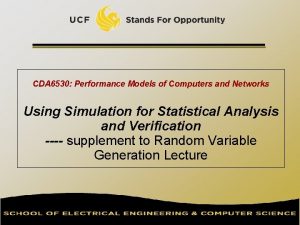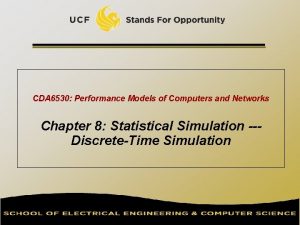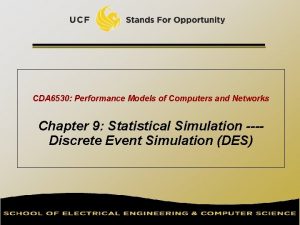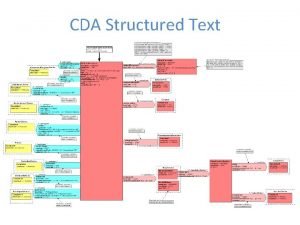CDA 6530 Performance Models of Computers and Networks







![Obtain Information q q Size(A): return [m n] Length(A): length of a vector q Obtain Information q q Size(A): return [m n] Length(A): length of a vector q](https://slidetodoc.com/presentation_image_h/c82940953a8ffc119ed3cf90d541defe/image-8.jpg)








![3 -D plot q q x=[0: 10]; y=[0: 10]; z=x’*y; mesh(x, y, z); figure; 3 -D plot q q x=[0: 10]; y=[0: 10]; z=x’*y; mesh(x, y, z); figure;](https://slidetodoc.com/presentation_image_h/c82940953a8ffc119ed3cf90d541defe/image-17.jpg)









- Slides: 26

CDA 6530: Performance Models of Computers and Networks Chapter 4: Using Matlab for Performance Analysis and Simulation

Objective q Learn a useful tool for mathematical analysis and simulation q q q Interpreted language, easy to learn Use it to facilitate our simulation projects A good tool to plot simulation/experiment results figures for academic papers More powerful than excel q Could directly create. eps for Latex q 2

Introduction q q Mat. Lab : Matrix Laboratory Numerical Computations with matrices q q Every number can be represented as matrix Why Matlab? User Friendly (GUI) q Easy to work with q Powerful tools for complex mathematics q q Matlab has extensive demo and tutorials to learn by yourself q Use help command 3

Matlab Software Access q q all UCF in-campus computers have student-version Matlab installed If you have no access to Matlab, you can use Octave, an open-source free software q q http: //www. gnu. org/software/octave/ The programming should be almost identical 4

Matrices in Matlab q To enter a matrix 2 5 3 6 4 1 >> A = [2 5 3; 6 4 1] >> B = [1: 1. 5: 6; 2 3 4 5] >> for i=1: 4 for j=1: 3 C(i, j)=i*j; end >> D =[]; D=[D; 5]; D=[D; 6; 7] >> E = zeros(4, 5) 5

Basic Mathematical Operations Remember that every variable can be a matrix! Addition: >> C = A + B Subtraction: >> D = A – B Multiplication: >> E = A * B (Matrix multiplication) >> E = A. * B (Element wise multiplication, A and B same size) Division: Left Division and Right Division >> F = A. / B (Element wise division) >> F = A / B = A*inv(B) (A * inverse of B) >> F = A. B (Element wise division) >> F = A B=inv(A)*B (inverse of A * B) 6

Generating basic matrices Matrix with ZEROS: >> A = zeros(m, n) Matrix with ONES: >> B = ones(m, n) IDENTITY Matrix: >> I = eye(m, n) m Rows n Columns zeros, ones, eye Matlab functions 7
![Obtain Information q q SizeA return m n LengthA length of a vector q Obtain Information q q Size(A): return [m n] Length(A): length of a vector q](https://slidetodoc.com/presentation_image_h/c82940953a8ffc119ed3cf90d541defe/image-8.jpg)
Obtain Information q q Size(A): return [m n] Length(A): length of a vector q q B = A(2: 4, 3: 5) q q Length(A) = max(size(A)) B is the subset of A from row 2 to row 4, column 3 to column 5 A(: , 2)=[] q Delete second column 8

Basic Matrix Functions q q q Inv(A): inverse of A Rank(A): rank of matrix A A’: transpose of A Det(A): determinant V= eig(A): eigenvalue vector of A q [V, D] = eig(A) produces matrices of eigenvalues (D) and eigenvectors (V) of matrix A, so that A*V = V*D 9

Random Number Generators q Rand(m, n): matrix with each entry ~ U(0, 1) q q You can use this for the programming project 1 Randn(m, n): standard normal distribution q q You cannot use this in programming project 1 You must use the polar method I introduced! 10

Basic 2 -D Figure Plot q Plot(X, Y): q Plots vector Y versus vector X q Hold: next plot action on the same figure Title(‘title text here’) Xlabel(‘…’), ylabel(‘…’) Axis([XMIN XMAX YMIN YMAX]) Legend(‘…’) Grid q Example demo q q q 11

Elementary Math Function q Abs(), sign() q q q Sign(A) = A. /abs(A) Sin(), cos(), asin(), acos() Exp(), log 10() Ceil(), floor() Sqrt() Real(), imag() 12

Elementary Math Function q Vector operation: Max(), min(): max/min element of a vector q Mean(), median() q Std(), var(): standard deviation and variance q Sum(), prod(): sum/product of elements q Sort(): sort in ascending order q 13

Save/Load Data q Save fname Save all workspace data into fname. mat q Save fname x y z q Save(fname): when fname is a variable q q Load fname q q q Load fname x y No error in data You can run simulation intermittently q Save/load data between runs 14

Input/Output for Text Files q Input data file for further analysis in Matlab q Run simulation using C q q Use Matlab for post-data processing q q Matrix calculation, utilize Matlab math functions Simply use Matlab for figure ploting q q matlab is slow in doing many loops Excel has constraint on data vector length (<300? ) Functions: q [A, B…]= Textread(fname, format) q q Read formated data Use fprintf(), fscanf() similar to C q q Note that variables here can be vectors/matrices Show examples here of writing data to text file 15

Advanced Graph q Subplot(m, n, p) q q breaks the Figure window into an m-by-n matrix of small axes, selects the p-th axes for the current plot, and returns the axis handle. Semilogx(), semilogy(), loglog() 16
![3 D plot q q x0 10 y0 10 zxy meshx y z figure 3 -D plot q q x=[0: 10]; y=[0: 10]; z=x’*y; mesh(x, y, z); figure;](https://slidetodoc.com/presentation_image_h/c82940953a8ffc119ed3cf90d541defe/image-17.jpg)
3 -D plot q q x=[0: 10]; y=[0: 10]; z=x’*y; mesh(x, y, z); figure; surf(x, y, z); 17

M-file q Script or function q q q Scripts are m-files containing MATLAB statements Functions are like any other m-file, but they accept arguments It is always recommended to name function file the same as the function name function A = change. Sign(B) % change sign for each element [m, n] = size(B); A = zeros(m, n); for i=1: m for j=1: n A(i, j)= -B(i, j); end return 18

Online Tutorials q q Matlab itself contains many tutorials Other online tutorials: http: //www. math. siu. edu/matlab/tutorials. html q http: //www. cs. cmu. edu/~ggordon/780/lecture s/matlab_tutorial. pdf q Google search “matlab tutorial ppt” to find a lot more q 19

Example on Using Matlab for Markov Chain Steady State Calculation 20

q q Discrete-time Markov Chain transition matrix: ¼ P = ¼ , ¼ [1 1 1… 1]T = 1 ¼ (P – I) = 0, But we cannot use it directly T q Replace first column in (P-I) with [1 1. . 1] to be A, then we can solve the linear equation set by ¼ = [1 0 0 … 0] A-1 q q Another way: P*P*P*P…… 21

Tutorial on Matlab Simulink 22

q Graphical programming language q q q Powerful modeling tool q q q Differential Equations Physiological systems Control systems Transfer functions M-file can call a simulink model q q q Drag and draw line to program Configure each object for parameters “sim fname” Use current workspace variables Simulation results can be saved to workspace variables q Thus can be process after simulink 23

Example: Internet Worm Propagation q q q N: vulnerable population : worm host average scan rate : scanning IP space size 24

Example 2: RC Circuit Transfer function: 25

Save result to workspace variables q q q the save format is "structure with time". Suppose the workspace variable is X_t. Then: q X_t. time saves the simulation step times (vector) X_t. signals. values saves the simulation results (vector). plot(X_t. time, X_t. signals. values); Variable step simulation or fixed step simulation: q q "to workspace" use "-1" for sample time (inherited) q q Then X_t. time has variable size "to workspace" use "1" for sample time q Then each time tick has one result value 26
 Difference between datagram and virtual circuit
Difference between datagram and virtual circuit Basestore iptv
Basestore iptv Difference between modal and semi modal verbs
Difference between modal and semi modal verbs Delay models in data networks
Delay models in data networks Network performance measurement in computer networks
Network performance measurement in computer networks Network performance measurement
Network performance measurement Router node
Router node Performance metrics in computer networks
Performance metrics in computer networks Router node
Router node Team performance models
Team performance models Dazed and confused cda
Dazed and confused cda Chapter 11 performance appraisal - (pdf)
Chapter 11 performance appraisal - (pdf) Performance appraisal process
Performance appraisal process 2018 jcids manual
2018 jcids manual Repetititon
Repetititon Cda examples competency statements
Cda examples competency statements Mary ainsworth
Mary ainsworth Kate cda
Kate cda Pacific rim2 cda
Pacific rim2 cda Charlie chaplin cda
Charlie chaplin cda The mime cda
The mime cda Cda 3101
Cda 3101 Continuity of care document template
Continuity of care document template Palimpsest cda
Palimpsest cda Reflective dialogue worksheet cda
Reflective dialogue worksheet cda Redeemer film cda
Redeemer film cda Intervjubakgrund
Intervjubakgrund




